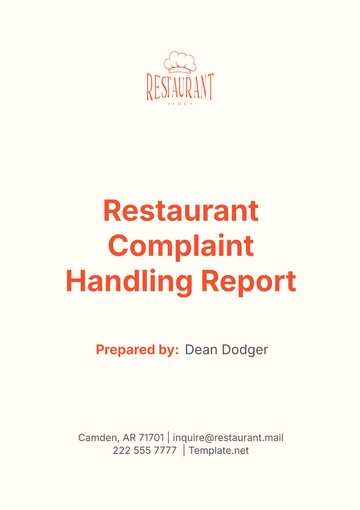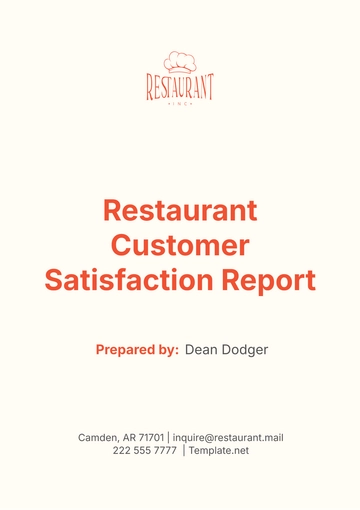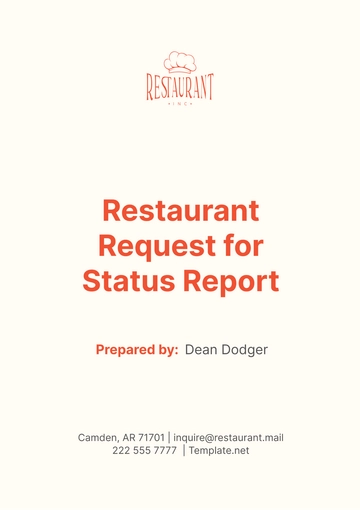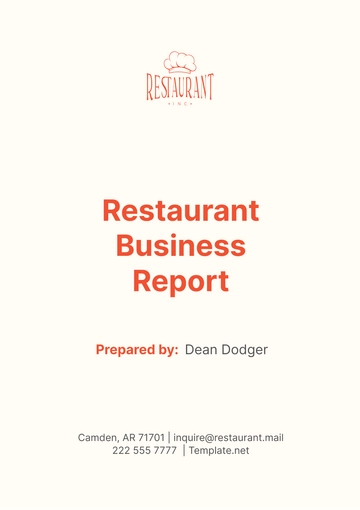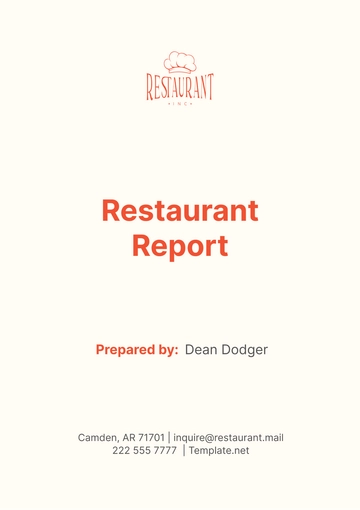Free Restaurant Sales Daily Report

I. Introduction
The purpose of this daily sales report is to provide a comprehensive overview of [Your Company Name]'s sales performance on [Date]. This report aims to track the daily sales revenue, analyze customer trends, monitor inventory levels, and assess staff performance. By doing so, it will help identify areas for improvement and facilitate strategic decision-making to enhance operational efficiency and financial health.
Daily sales tracking is essential for understanding the restaurant’s financial position and operational dynamics. It allows management to quickly identify trends, spot potential issues, and implement corrective measures. This report serves as a crucial tool for ensuring that [Your Company Name] remains competitive and meets its business objectives.
II. Sales Summary
A. Total Sales
On [Date], [Your Company Name] generated a total sales revenue of $12,500. This marks a 5% increase compared to the previous day's revenue of $11,900. The increase is attributed to a successful promotional campaign and an uptick in customer traffic during the evening hours.
Date | Total Sales ($) | % Change from Previous Day |
|---|---|---|
May 14, 2024 | 11,900 | |
May 15, 2024 | 12,500 | +5% |
B. Sales by Category
Sales have been broken down into the following categories to provide a more detailed analysis:
Category | Sales Revenue ($) | % of Total Sales |
|---|---|---|
Food | 8,750 | 70% |
Beverages | 2,500 | 20% |
Desserts | 750 | 6% |
Specials | 500 | 4% |
The majority of sales revenue (70%) came from food items, indicating a strong preference among customers for our main dishes. Beverages accounted for 20% of the sales, while desserts and specials contributed 6% and 4% respectively.
C. Top Selling Items
The top-selling items for [Date], were:
Rank | Item Name | Units Sold | Sales Revenue ($) |
|---|---|---|---|
1 | Grilled Chicken Sandwich | 120 | 1,800 |
2 | Caesar Salad | 100 | 1,500 |
3 | Iced Coffee | 150 | 1,200 |
4 | Chocolate Cake | 75 | 750 |
5 | Shrimp Tacos | 60 | 900 |
D. Sales by Time Period
Sales performance varied throughout the day, with notable peaks during lunch and dinner hours:
Time Period | Sales Revenue ($) | % of Total Sales |
|---|---|---|
Breakfast | 1,500 | 12% |
Lunch | 5,000 | 40% |
Dinner | 5,500 | 44% |
Late Night | 500 | 4% |
Lunch and dinner periods were the most profitable, contributing 40% and 44% to the total daily sales respectively.
III. Payment Methods
A. Sales by Payment Type
The breakdown of sales by payment type is as follows:
Payment Method | Sales Revenue ($) | % of Total Sales |
|---|---|---|
Cash | 3,000 | 24% |
Credit/Debit | 8,000 | 64% |
Mobile Payment | 1,500 | 12% |
The majority of transactions (64%) were made via credit/debit cards, indicating a preference for electronic payments among customers.
B. Average Transaction Value
The average transaction value for each payment method is calculated as follows:
Payment Method | Total Transactions | Average Transaction Value ($) |
|---|---|---|
Cash | 200 | 15 |
Credit/Debit | 400 | 20 |
Mobile Payment | 100 | 15 |
Credit/debit card transactions had the highest average value at $20 per transaction.
IV. Customer Insights
A. Number of Customers Served
A total of 700 customers were served on [Date]. This reflects a significant volume of foot traffic and highlights the restaurant's popularity among locals and visitors alike.
B. Average Spend per Customer
The average spend per customer is calculated by dividing the total sales revenue by the number of customers served. So, the average spend per customer was approximately $17.86.
C. Customer Feedback
Customer feedback for the day was largely positive. Key points of feedback included:
Service Quality: Several customers praised the prompt and friendly service provided by the staff.
Food Quality: Many customers appreciated the taste and presentation of the dishes, particularly the top-selling items.
Ambiance: Positive comments were made about the restaurant's ambiance, contributing to an enjoyable dining experience.
Improvement Areas: A few customers suggested adding more vegetarian options to the menu.
V. Inventory and Waste
A. Inventory Levels
Starting and ending inventory levels for key items were monitored to manage stock effectively:
Item Name | Starting Inventory | Ending Inventory | Units Sold |
|---|---|---|---|
Grilled Chicken Sandwich | 150 | 30 | 120 |
Caesar Salad | 120 | 20 | 100 |
Iced Coffee | 200 | 50 | 150 |
Chocolate Cake | 100 | 25 | 75 |
Shrimp Tacos | 80 | 20 | 60 |
Regular monitoring of inventory levels ensures that the restaurant can meet customer demand without overstocking, which helps in maintaining optimal stock levels and minimizing waste.
B. Waste Report
The waste report for [Date], is as follows:
Item Name | Wasted Units | Reason for Waste |
|---|---|---|
Grilled Chicken Sandwich | 10 | Overcooked |
Caesar Salad | 5 | Wilted lettuce |
Iced Coffee | 10 | Spillage |
Chocolate Cake | 3 | Stale |
Shrimp Tacos | 2 | Spoilage due to storage |
Efforts are being made to minimize waste by improving inventory management and staff training on food handling and storage practices.
VI. Staff Performance
A. Employee Sales Performance
Assessing the performance of individual employees provides insights into their efficiency and effectiveness in driving sales. For [Date], the sales performance of key staff members is as follows:
Employee Name | Role | Total Sales Generated ($) | Number of Transactions | Average Transaction Value ($) |
|---|---|---|---|---|
Server | 3,000 | 150 | 20 | |
Server | 2,500 | 130 | 19.23 | |
Bartender | 2,000 | 100 | 20 | |
Cashier | 2,000 | 110 | 18.18 | |
Hostess | 1,000 | 50 | 20 |
[Name] led the team with the highest sales, reflecting his effectiveness in upselling and engaging with customers. [Name] also performed well, closely followed by [Name] and [Name]. [Name], though in a role with less direct sales interaction, managed a significant average transaction value.
B. Shift Reports
Detailed shift reports help in understanding the sales performance and operational challenges encountered during different parts of the day:
Shift | Time Period | Total Sales ($) | Number of Transactions | Comments |
|---|---|---|---|---|
Morning Shift | 8 AM - 12 PM | 1,500 | 100 | Smooth operation, moderate traffic |
Afternoon Shift | 12 PM - 4 PM | 4,000 | 200 | High customer traffic, promotional deals boosted sales |
Evening Shift | 4 PM - 8 PM | 5,500 | 250 | Peak hours, excellent team performance |
Night Shift | 8 PM - 12 AM | 1,500 | 75 | Steady flow, minimal issues |
The evening shift was the most profitable, generating $5,500 in sales. This period also had the highest number of transactions, indicating a peak in customer visits.
VII. Promotions and Discounts
A. Promotional Sales
Promotional activities play a crucial role in attracting customers and boosting sales. On [Date], [Your Company Name] ran a "Happy Hour" promotion offering discounts on selected beverages and appetizers from 4 PM to 6 PM.
Promotion Name | Time Period | Items on Promotion | Sales Revenue ($) | Number of Items Sold |
|---|---|---|---|---|
Happy Hour | 4 PM - 6 PM | Beverages, Appetizers | 2,000 | 300 |
The "Happy Hour" promotion generated $2,000 in sales and contributed to a higher customer turnout during the evening hours.
B. Discounts and Coupons
Tracking the impact of discounts and coupons helps in understanding their effectiveness and customer preferences.
Discount/Coupon Type | Number Redeemed | Total Discount Value ($) | Impact on Sales ($) |
|---|---|---|---|
10% Off Next Visit | 50 | 500 | 5,000 |
Free Dessert | 30 | 150 | 450 |
Buy One Get One Free | 40 | 600 | 2,400 |
The "10% Off Next Visit" coupon was the most popular, with 50 redemptions, driving an additional $5,000 in sales. The "Buy One Get One Free" offer also significantly boosted sales, particularly during the lunch and dinner periods.
VIII. Challenges and Issues
A. Operational Challenges
Several operational challenges were encountered on [Date]. Addressing these issues promptly is crucial to maintaining smooth operations and customer satisfaction.
Challenge | Description | Resolution Strategy |
|---|---|---|
Equipment Malfunction | One of the ovens broke down during the evening | Immediate repair request, temporary workaround using remaining ovens |
Staffing Shortage | A server called in sick, leading to a staff shortage | Manager assisted with serving, adjusted break schedules to cover gaps |
Inventory Mismanagement | Shortage of key ingredients for a popular dish | Emergency restock order placed, offered alternatives to customers |
Despite these challenges, the team effectively managed the operations, ensuring minimal impact on customer experience.
B. Customer Complaints
Customer feedback is essential for improving service quality and addressing issues proactively. On [Date], the following customer complaints were recorded:
Complaint | Number of Complaints | Resolution |
|---|---|---|
Slow Service | 5 | Apologies offered, complimentary drinks given, reviewed staffing levels during peak hours |
Food Quality | 3 | Replacements provided, investigated kitchen procedures to ensure consistency |
Noise Level | 2 | Adjusted seating arrangements, added sound-absorbing panels |
The majority of complaints were related to slow service during peak hours, which were promptly addressed by offering complimentary drinks and reviewing staffing levels.
IX. Recommendations and Action Plan
A. Areas for Improvement
Based on the analysis of the day's performance, several areas for improvement have been identified:
Staff Training: Enhance training programs to improve efficiency and customer service during peak hours.
Inventory Management: Implement a more robust inventory management system to prevent shortages and overstocking.
Promotions: Optimize promotional strategies based on customer preferences and sales data.
B. Action Items
Specific action items have been outlined to address the challenges and enhance overall performance:
Action Item | Responsible Party | Deadline | Notes |
|---|---|---|---|
Implement a staff training program | HR Department | Focus on customer service and efficiency | |
Upgrade inventory management system | Operations Manager | Evaluate and select appropriate software | |
Review promotional strategies | Marketing Team | Analyze sales data to refine promotions | |
Conduct equipment maintenance check | Maintenance Team | Regular maintenance to prevent breakdowns |
These action items are aimed at improving operational efficiency, enhancing customer satisfaction, and driving sales growth.
X. Conclusion
A. Summary
The sales performance on [Date], for [Your Company Name] was strong, with a total sales revenue of $12,500. The analysis highlighted key trends in customer preferences, sales by category, and the effectiveness of promotional activities. Despite facing several operational challenges, the team managed to maintain a high level of customer satisfaction.
B. Next Steps
Moving forward, the focus will be on implementing the identified action items to address areas for improvement. This includes enhancing staff training, upgrading inventory management systems, and optimizing promotional strategies. Regular monitoring and analysis will continue to ensure that [Your Company Name] remains competitive and meets its business objectives.
- 100% Customizable, free editor
- Access 1 Million+ Templates, photo’s & graphics
- Download or share as a template
- Click and replace photos, graphics, text, backgrounds
- Resize, crop, AI write & more
- Access advanced editor
Track daily sales efficiently with Template.net's Restaurant Sales Daily Report Template. This customizable and editable template, accessible through the Ai Editor Tool, helps you record and analyze daily sales data. Personalize it to fit your restaurant’s specific reporting needs. Develop a detailed and professional report to monitor performance, identify trends, and make informed business decisions.
You may also like
- Sales Report
- Daily Report
- Project Report
- Business Report
- Weekly Report
- Incident Report
- Annual Report
- Report Layout
- Report Design
- Progress Report
- Marketing Report
- Company Report
- Monthly Report
- Audit Report
- Status Report
- School Report
- Reports Hr
- Management Report
- Project Status Report
- Handover Report
- Health And Safety Report
- Restaurant Report
- Construction Report
- Research Report
- Evaluation Report
- Investigation Report
- Employee Report
- Advertising Report
- Weekly Status Report
- Project Management Report
- Finance Report
- Service Report
- Technical Report
- Meeting Report
- Quarterly Report
- Inspection Report
- Medical Report
- Test Report
- Summary Report
- Inventory Report
- Valuation Report
- Operations Report
- Payroll Report
- Training Report
- Job Report
- Case Report
- Performance Report
- Board Report
- Internal Audit Report
- Student Report
- Monthly Management Report
- Small Business Report
- Accident Report
- Call Center Report
- Activity Report
- IT and Software Report
- Internship Report
- Visit Report
- Product Report
- Book Report
- Property Report
- Recruitment Report
- University Report
- Event Report
- SEO Report
- Conference Report
- Narrative Report
- Nursing Home Report
- Preschool Report
- Call Report
- Customer Report
- Employee Incident Report
- Accomplishment Report
- Social Media Report
- Work From Home Report
- Security Report
- Damage Report
- Quality Report
- Internal Report
- Nurse Report
- Real Estate Report
- Hotel Report
- Equipment Report
- Credit Report
- Field Report
- Non Profit Report
- Maintenance Report
- News Report
- Survey Report
- Executive Report
- Law Firm Report
- Advertising Agency Report
- Interior Design Report
- Travel Agency Report
- Stock Report
- Salon Report
- Bug Report
- Workplace Report
- Action Report
- Investor Report
- Cleaning Services Report
- Consulting Report
- Freelancer Report
- Site Visit Report
- Trip Report
- Classroom Observation Report
- Vehicle Report
- Final Report
- Software Report









